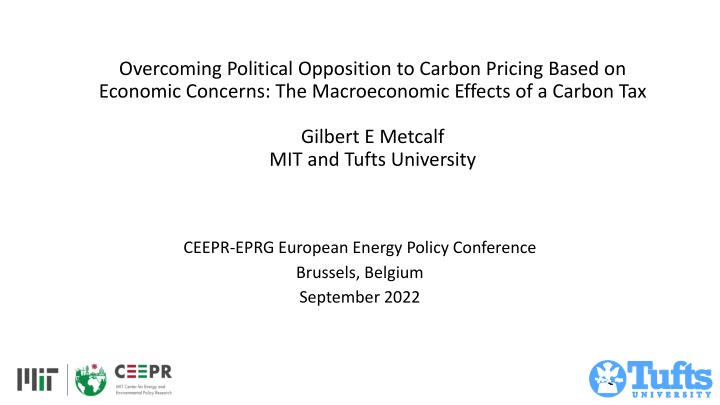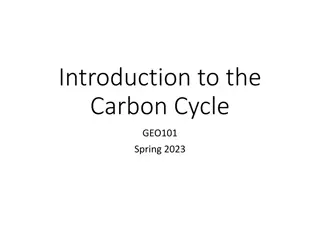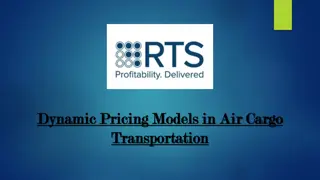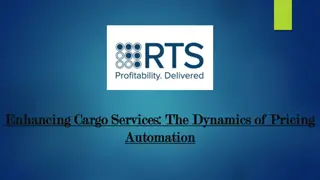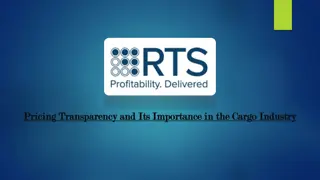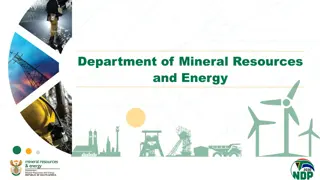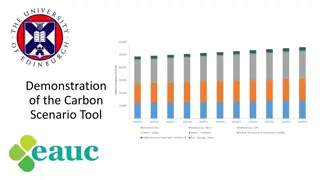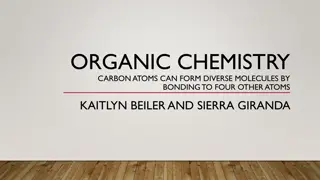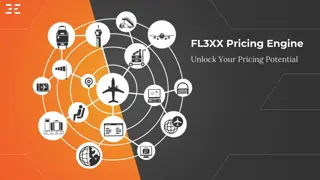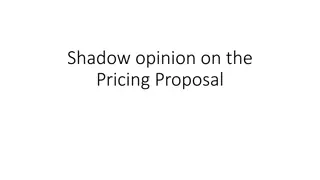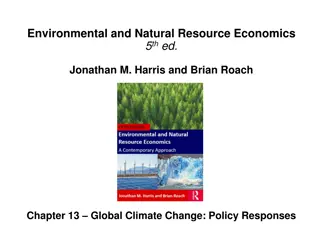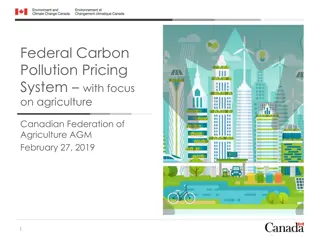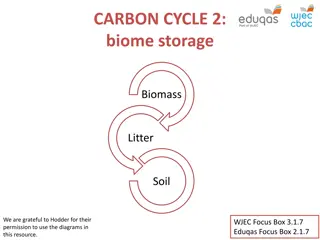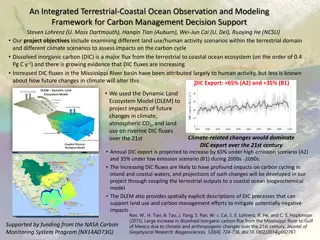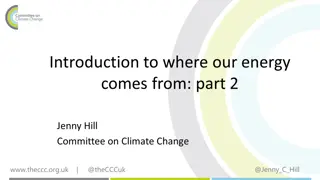Economic Impacts of Carbon Pricing Policy Insights
This collection of studies delves into the economic implications of carbon pricing, addressing concerns and providing evidence from real-world examples to debunk misconceptions. Insights from various countries' carbon tax implementations and analyses shed light on the macroeconomic effects of such policies, offering valuable lessons for policymakers and stakeholders.
Download Presentation

Please find below an Image/Link to download the presentation.
The content on the website is provided AS IS for your information and personal use only. It may not be sold, licensed, or shared on other websites without obtaining consent from the author.If you encounter any issues during the download, it is possible that the publisher has removed the file from their server.
You are allowed to download the files provided on this website for personal or commercial use, subject to the condition that they are used lawfully. All files are the property of their respective owners.
The content on the website is provided AS IS for your information and personal use only. It may not be sold, licensed, or shared on other websites without obtaining consent from the author.
E N D
Presentation Transcript
Overcoming Political Opposition to Carbon Pricing Based on Economic Concerns: The Macroeconomic Effects of a Carbon Tax Gilbert E Metcalf MIT and Tufts University CEEPR-EPRG European Energy Policy Conference Brussels, Belgium September 2022
Opposition to Decarbonizing the Economy Two levels of opposition based on economic grounds Sector specific losses from greening the economy (lost fossil fuel jobs, higher costs of energy) General concern about its impacts on the economy The first concern speaks to need for transitional assistance The second concern is overblown Emerging real-world evidence undercuts this second concern Carbon pricing is not a job or economy killer 2
British Columbia Carbon Tax Employment Impacts 0.74 percent higher employment Yamazaki (2017) 3
BC Carbon Tax: Sectoral Shifts Low Carbon Intensity High Carbon Intensity Yamazaki (2017) 4
What is the Economic Cost of Carbon Pricing? Analysis by Metcalf and Stock, The Macroeconomic Impact of Europe s Carbon Taxes, American Economic Journal: Macroeconomics, forthcoming Also, some discussion of mechanisms in Finkelstein Shapiro and Metcalf (2022), The Macroeconomic Effects of a Carbon Tax to Meet the U.S. Paris Agreement Target: The Role of Firm Creation and Technology Adoption, submitted 5
History and Coverage Carbon taxes in 2018 Year of Adoption Country Rate in 2018 (USD) Coverage (2019) Finland Poland Norway Sweden Denmark Slovenia Estonia Latvia Switzerland Ireland Iceland UK Spain France Portugal 1990 1990 1991 1991 1992 1996 2000 2004 2008 2010 2010 2013 2014 2014 2015 $70.65 0.16 49.30 128.91 24.92 29.74 3.65 9.01 80.70 24.92 25.88 25.71 30.87 57.57 11.54 0.36 0.04 0.62 0.40 0.40 0.24 0.03 0.15 0.33 0.49 0.29 0.23 0.03 0.35 0.29 Source: World Bank https://carbonpricingdashboard.worldbank.org/ 6
Evidence from European Carbon Taxes Carbon tax history for the 15 countries with carbon taxes Data source: World Bank (carbon price data in press) Carbon tax rates are real local currency, scaled to 2018 USD using 2018 PPP GDP growth: World Bank (except as noted below) Metcalf and Stock (2020, NBER) 7
Case Study Sweden 11
Metcalf and Stock Approach Estimand: cumulative dynamic causal effect of change in tax rate on real variables Two methods, one exogeneity condition (identifying assumptions) = + , t ( ) ln( L ) ,... ,... t W W + + + Local projections (panel) ln( / ) (L) ), W W ) (L) GDP E u GDP | , t E u GDP W u t h + ,..., ln( 1 , 1 1 t yx h t GDP t t t t ( Exogeneity condition: 1 , 1 1 , t t t t ( ) = ,..., ln( | ), GDP 1 2 1 1 t t t t t Note: is h-period ahead cumulative impulse response function in VAR jargon , yx h Panel VAR: Same identifying assumption as LP Restricted or unrestricted: Impose zero long-run effect on growth (restricted), or not (unrestricted) Identification is coming from the time series variation: think SVAR , not event study 12
Methods Additional Details o All regressions include country & year fixed effects o Carbon tax enters weighted by coverage share o Standard errors: heteroskedasticity-robust for SVAR and LP (Plagborg-M ller and Wolf (2019)) o Effects calibrated to $40 carbon tax at 0% real increase; tax covers 30 percent of emissions Tax innovations are solved from IRF of tax shock to tax rate IRF (Sims (1986) method) o 4 lags of control variables used (base case) 13
Empirical Findings Based on Statistical Analysis Simulation of a $40 per ton carbon tax applied to 30 percent of emissions (average for EU) Figure shows impact on GDP Metcalf and Stock (2022) 14
Employment Growth Impacts Metcalf and Stock (2022) 15
Manufacturing Employment Growth Impacts Metcalf and Stock (2022) 16
Emissions Impacts Cumulative impact of carbon tax impulse on the level of emissions Emissions from fuel consumption
Results: Additional Questions & Sensitivity Analysis 1. Are the results driven by: Scandinavia? No: results for SCA-only, or EUxSCA, are similar to overall results, just noisier Countries that have low taxes? No: very similar results if you use only countries with tax of at least $10/ton share- weighted ($40/ton x 30% coverage = $12/ton share-weighted) Carbon tax data decisions? No. Essentially no difference in results if we use the Dolphin et al. (2019) carbon tax rates, see the paper 2. Are the positive GDP and employment results a consequence of how the country uses the revenue? No. Essentially no difference in results if we focus on revenue recycling countries only 18
Why is the impact so muted? Finkelstein Shapiro and Metcalf (2022) build a CGE model to assess the impact of a carbon tax in a world with Frictional unemployment Endogenous firm creation Endogenous technology adoption Model builds on the Dixit and Stiglitz (1977) model of endogenous product variety and increasing returns 19
Modeling Illustrates Key Points Failure to account for firm entry/exit and technology adoption distorts labor market outcomes More realistic market structure yields positive impacts: Negates adverse impacts on GDP and employment Lower carbon tax needed to achieve desired emission reduction Welfare cost of achieving the U.S. Paris Agreement goal modest (to zero), allowing for innovation and firm entry/exit Intuition: Dixit-Stiglitz market equilibrium is a second-best equilibrium. Carbon tax can help offset inefficiently low degree of product variety
Sticks vs. Carrots A carbon price penalizes emissions Subsidies to clean energy reward clean investment Most economists have promoted carbon pricing Inflation Reduction Act (IRA) mostly avoids penalties and rewards clean investment A clear winner politically but at what cost?
Emission Reduction Required for Biden NDC 6,500 6,000 5,500 5,000 MMmt CO2 4,500 4,000 35% 3,500 3,000 2,500 2005 2010 2015 2020 2025 2030 22 EIA Annual Energy Outlook (2020)
Carbon Tax Rate to Achieve Biden Commitment $120 450 400 $100 350 Annual Revenue (Billions) Dollars per metric ton $80 300 Comparable to US Treasury Analysis (2017) 250 $60 200 $40 150 100 $20 50 $0 0 No Technology Adoption or Firm Entry No Firm Entry Full Model Finkelstein Shapiro and Metcalf (2022)
Inflation Reduction Act: Key Elements Clean Electricity Production (s.45Y) and Investment (s.48D) Credits Full credit if prevailing wage and apprenticeship requirements met Bonus credits for meeting domestic content and energy community criteria Clean Vehicle Credit Full credit if critical battery materials extracted/processed in Free Trade Agreement Countries and final assembly in North America Lots of other provisions Methane fee for fugitive emissions Credits for clean technology advanced manufacturing Credits for existing nuclear and CCS Home energy credits Energy justice provisions
Projected Impacts of Inflation Reduction Act Projected to cut emissions 42 percent in 2030 relative to 2005 (REPEAT Project) 980 million metric tons reduction Power Sector Savings (37% of total reduction) Transportation Savings (29% of total reduction Major driver is tax credits Power sector investment and production EV purchases Advanced clean manufacturing Cost of tax incentives ~$40 billion in 2030 (CBO)
Summary European carbon taxes have had no measurable effect on GDP or employment growth Emission reductions are on the order of 4 to 6 percent for a $40 per ton carbon tax covering 30 percent of emissions Note that European carbon taxes tend to be on high marginal abatement cost sectors Transportation Building sector (heating) Carbon pricing cuts emissions cost effectively (and raises revenue) But tax credits are politically feasible
Thank you Gilbert (Gib) Metcalf MIT CEEPR
